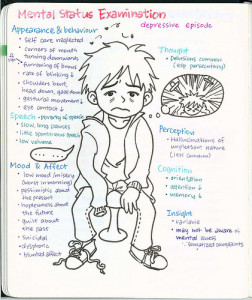“Oh Behave!” Austin Powers knew all to well that we toe a fine line as humans when it comes to ‘normal’ human behaviour. When we are doing a mental state exam we are observing the fine line between what our clinical brothers and sisters would call ‘normal’ and ‘abnormal’. Behaviour is an interesting phenomenon for youth workers to observe. It requires us to use our powers of observation and our own self reflection (apparently youth workers can be a little abnormal!) to determine whether a person is doing alright. We need to observe whether the young person is acting in a similar way to how they act most of the time or differently. Whether they are acting similar to their peers or completely different. Behaviour requires us to have an understanding of normal behaviour and abnormal behaviour.
 |
Normal day or abnormal behaviour?
|
Movements
Tremors, shakes, tics, involuntary movements may indicate a neurological disorder, or they could be the side effects of antipsychotic medication, schizophrenia or drug abuse. If your young person is showing these types of movements it may be normal for them or it might be abnormal. It may be something serious like a neurological disorder or it may just be the effects of the drugs they have used. Your ability to observe this behaviour and refer them out to more specialised support will be key.
This also goes if they are hyperactive, rocking, gesturing wildly, fidgeting or unable to sit still. This may mean they are delirious or manic, or it might just mean they are excited or full of beans. Only your keen observation of their movements and your deep relationship will tell you if something is out of the ordinary or ‘abnormal’.
Level of activity and arousal
A persons level of activity and arousal may also provide insight into their mental state. Are they hyperactive (high action) or lethargic (low action)? An increase in arousal and movement (hyperactivity) which might reflect mania or delirium. An inability to sit still might represent akathisia, a side effect of antipsychotic medication. Similarly a decrease in arousal and movement (akinesia or stupor) might indicate depression or a medical condition such as dementia or delirium.
Of course if you are over aroused and hyperactive you may just be having a birthday, bar mitzvah or a wedding. You may be on a camp and really excited. If your young people are lethargic it may just be the last day of camp, the end of a boring group session or a distressing break-up with a cherished boyfriend. Your keen understanding of your young people will help you to know whether or not it was the red cordial or sad movie that is making your young person behave differently or whether it is something else more insidious.
Eye contact
The eyes are the window to the soul they say, and never more so was this true than whilst doing a mental state exam. Does your young person make good eye contact with the floor? Can they look you in the eye? What happens when they are telling you porky pies??? A persons eye contact can say a lot about their mental state. It can tell you if they are lying. It can tell you if they are psychopathic. It can tell you if they are nervous, sad or depressed. Eye contact is one of the most important behavioural signposts for us as youth workers.
There are of course some caveats to this. If your young persons culture frowns on eye contact for example the aboriginal population in Australia. A young person will not make too much eye contact with an adult out of respect. A young person with eye issues such as having a lazy eye may not seem to be making good eye contact, but it may just be your view.
There is a danger
Behaviour is difficult to observe objectively. Not Impossible, but difficult. Most of us observe others behaviour subjectively. We watch through the lens of what we find appropriate. In some cases this is not an issue. We see someone hit their child with a lump of wood, or a person overdosing or a young person in a relationship with a 40 year old and our observation is that this is abnormal. For the most part this is right. When we start to look at others behaviour we must think about what they are thinking when they do this. Most of us do not behave inappropriately on purpose… too often anyway. There is also a number of theories from a number of very noted behavioural theorists that can help us determine whether a person is normal or abnormal.
Aside from the clear observable issues like shakes, poor eye contact or hyperactivity some peoples behaviour can just be different to us. One of the best way we know of to observe and relate to a person on a behavioural level is DISC. Disc is a quadrant based behavioural analysis tool which can help you to determine if another person is nuts or just in a different quadrant than you. Since doing some training in DISC and using this to view peoples behaviour I have found that my mental state exams (as well as my general observations) have become more clear.
PS. If you observe something that seems out of the ordinary, try to explain what it is. For example, ‘John seemed depressed’, will not get you much help from a clinician. However, if you say, ‘John seemed depressed as he was making poor eye contact, was mumbling and wouldn’t finish sentences’, then you are more likely to elicit a response from clinicians.
We hope this helps. See you next week for part three, Speech.




 The Mental State Exam covers eight areas of the person for us to keep an eye on:
The Mental State Exam covers eight areas of the person for us to keep an eye on: